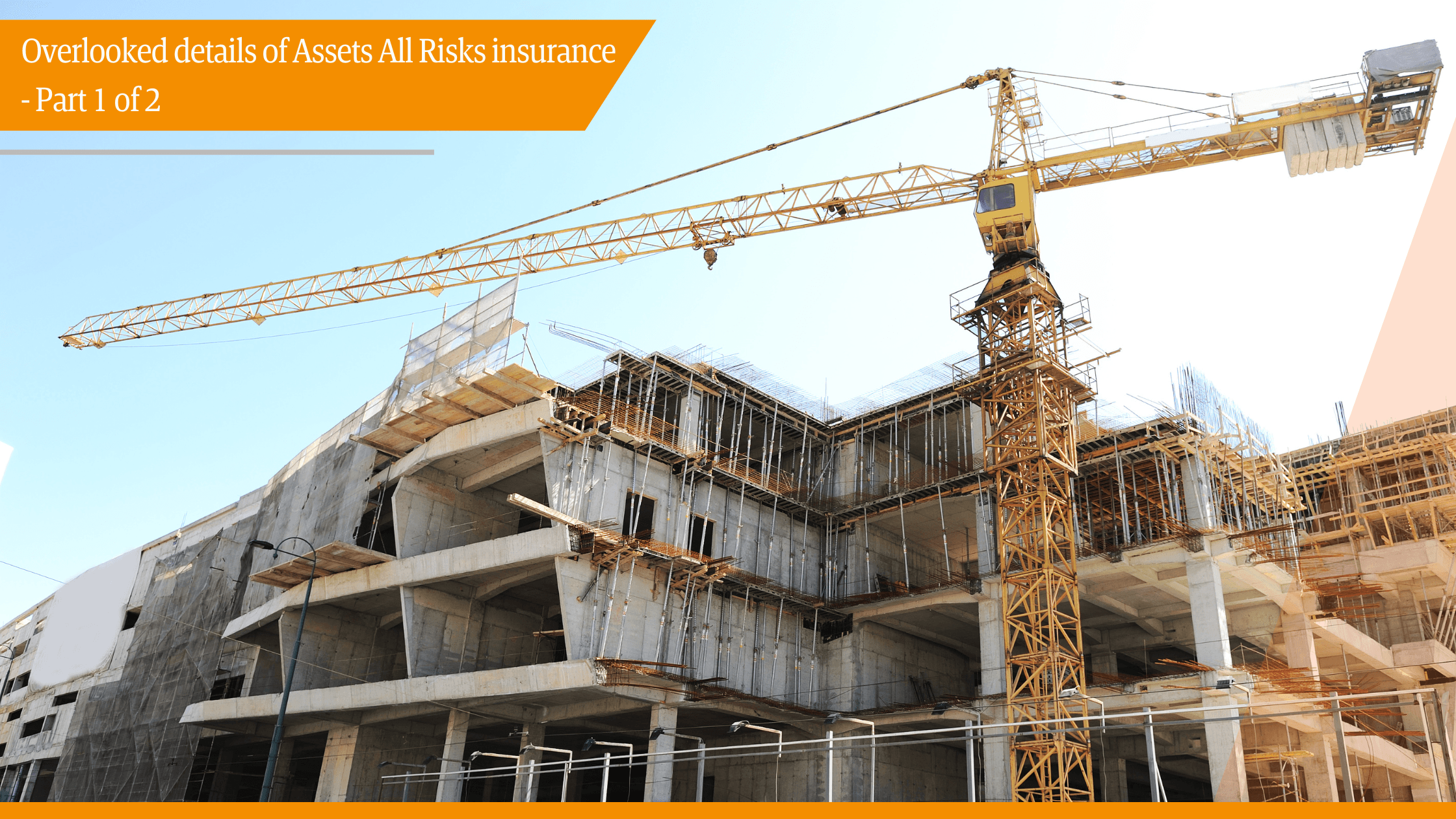Assets All Risks (AAR) insurance is often seen as straightforward: replace the damaged building and contents, reimburse for theft and malicious damage. But in reality, it’s far more complex, and the devil, as always, is in the details.
As a specialist underwriting manager in the provision of AAR insurance policies, PARTNER RISK has seen time and again how assumptions around cover lead to confusion, disputes, litigation and – in the worst cases – financial devastation for clients when an uninsured loss occurs.
This month, we take a closer look at what brokers need to know to help clients go beyond the basics and truly understand what an AAR policy covers, what it doesn’t, and how to build comprehensive protection that holds up when it matters most.
The Comfort of Cover: Why Assumptions Can Be Dangerous
When brokers present a commercial insurance policy to a client, the big-ticket items like fire, theft, flood, and storm damage are usually top of mind. Cover for these perils is expected, and rightly so. But many policies contain sub-limits, exclusions, and technical definitions that can dramatically affect the client’s claim payout after an insured loss.
Too often, clients assume that “damage” automatically includes everything associated with rebuilding – from removing rubble, to temporary security, to compliance with updated building codes. But unless the policy specifically provides for these costs, they may fall outside the scope of cover.
This disconnect between perceived protection and actual indemnity is one of the key reasons brokers must scrutinise cover in detail, particularly in high-value and complex risks.
Beyond Bricks and Mortar: What Could the Broker Overlook?
Here are some key areas brokers should explore with their commercial clients to avoid costly oversights:
- Debris Removal
Clearing a damaged or destroyed structure is the first, and often most expensive, step following a major loss. Debris removal is not automatically included in all property policies, or it may be capped at a fixed amount. Brokers should ensure this cover is specifically stated and adequate for the size and type of risk.
- Fire Brigade Charges
Some municipalities in South Africa charge for fire services, especially in private or industrial zones. These fees can be substantial. A comprehensive policy should include an extension to cover these charges.
- Professional Fees
After a major claim, professional fees (architects, engineers, quantity surveyors) are usually required to ensure rebuilding meets standards. These fees are often overlooked or underinsured. Check if the policy includes a specific extension to cover professional costs in addition to the building sum insured.
- Compliance with Building Regulations
Reinstating a building post-loss must comply with the latest building codes. If the original structure is outdated, the cost to upgrade (e.g. fire safety, accessibility) can be substantial. Policy extensions for “Public Authority Requirements” or “Reinstatement of Buildings on a New Basis” are vital in this context.
- Loss of Rental or Business Income
For clients who lease property, loss of rent or business interruption cover is crucial. It ensures income continuity while the premises are being repaired or rebuilt. Many commercial clients are unaware that this is not part of standard property cover unless specifically added.
- Security Upgrades Post-Claim
Following a break-in or malicious damage, clients often invest in upgraded security systems. A good policy should respond not only to the damage but also provide funds for improved preventative measures post-event.
- Tenant Improvements
In multi-tenanted buildings or leased premises, it’s easy to overlook tenant improvements such as partitions, HVAC installations or custom interiors. These improvements may not be covered unless explicitly added to the policy schedule or catered for via extensions.
- Territorial Scope
While AAR insurance is designed to cover a client’s assets on a blanket basis, there are usually territories that would be excluded by the insurers. Cover is seldom on a worldwide basis except for certain types of goods as specified in the schedule. Assets in sanctioned territories and entities would also be excluded.
- Day One Average
It is imperative for brokers to impress upon clients to fully declare their assets at current replacement/reinstatement values at inception of cover, as per the agreed basis of valuation. There is a limited degree of underinsurance that would be allowed (usually not more than 10%), which, if exceeded, may result in the client being harshly penalised at claims stage by having their claim payment proportionally reduced by the degree of underinsurance.
- Non-Damage Exclusion
Following the COVID-19 pandemic, most AAR policies now have an overarching non-damage exclusion such that only losses that result from physical damage following an insured event at the client, customers, suppliers and utility supplier’s premises would be covered. Brokers should always be mindful of this physical damage requirement and causal link when arranging cover and extensions for their clients.
- Excluded Occupancies
Insurers may have specifically excluded certain occupancies in their underwriting subjectivities. Brokers must ensure that every location/site in a widely dispersed risk is engaged in an economic activity that falls within the universal ambit of risk occupancies acceptable to the insurer, or to the co-insurers on a collective placement.
- Mid-Term Asset Acquisitions
Additional assets acquired during the currency of a policy and added to the policy either by direct endorsement or in terms of an extension (like capital additions or automatic investments), have to be employed in the same economic activity as the original insured entity. Otherwise, there could be a material change in risk resulting in different underwriting terms being imposed – or, at worst, exclusion from cover if they fall outside the risk profile acceptable to the insurer or co-insurers.
- Consequential Losses
There is a limitation to consequential losses that can be covered under the policy, and each instance must follow physical damage caused by an insured peril. These consequential losses are specified in the policy (e.g. loss of a licence, fines and penalties, etc.). Brokers must ensure that desired consequential losses – besides the usual loss of revenue, gross profit, and rentals – are agreed in advance with insurers and appropriately sub-limited, or else they will be excluded.
- Deductibles
These limit the cover provided, and some deductibles may be punitive and substantial, requiring implementation of certain risk requirements before they can be waived. Brokers should impress upon clients the need to comply with risk requirements as identified by insurers in order to secure the desired cover.
- Indemnity Periods
It is imperative for brokers to set appropriate indemnity periods on consequential loss covers. While insurers are loath to provide excessively long indemnity periods, an inadequate indemnity period – set merely to reduce the premium – may reduce the indemnity payment a client receives following an insured loss.
The Role of the Broker: Curator of Clarity
As the insurance landscape becomes more sophisticated, the role of the broker evolves from product selector to trusted risk adviser. This means asking deeper questions, verifying the values at risk, and understanding the operational impact of an insured loss, not just the physical repair costs.
Brokers who take the time to guide clients through the full scope of cover not only reduce the risk of disputes, they strengthen client relationships by demonstrating foresight, expertise and care.
Risk Improvement as Part of the Conversation
At PARTNER RISK, we believe comprehensive property cover isn’t just about paying claims – it’s about reducing the likelihood and impact of claims through proactive risk management. That’s why we work closely with brokers to identify areas for improvement and recommend appropriate preventative measures. These are usually communicated in an underwriting survey report, where risk recommendations and risk improvement requirements for the insured client are stipulated by the insurer.
These conversations often lead to better underwriting terms and long-term savings for the client. Our approach combines technical expertise, fast turnaround times, and a deep understanding of commercial realities. We see our brokers as partners, not just in distribution, but in delivering certainty to South African businesses.
Read the Fine Print. Then Rewrite It.
Commercial property policies should evolve with the businesses they protect. A building may remain the same on the outside, but the way it’s used, maintained, and valued can change dramatically over time. Brokers who challenge the standard and suitability of cover, ask the tough questions, and tailor protection based on true exposures are the ones who set themselves apart.
Because when a loss happens, your client isn’t relying on what was said – rather they’re relying on the promise made in the insurance contract, the policy.


